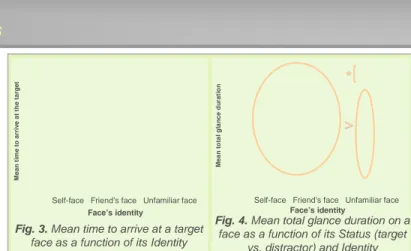Background
For 50 years, debates oppose partisans of a late selection of attention to partisans of an early selection of attention. To resolve these debates, highly important stimuli (e.g., one’s own name or face) have been used to determine whether they can be processed in conditions where they are supposedly unattended. Results were quite discrepant as some studies showed that those stimuli
automatically capture attention (e.g. Wolford & Morrison, 1980) while others showed that they do not (e.g. Bundesen et al., 1997).
A recent study (Devue & Brédart, 2008) suggests that self-referential stimuli might retain attention once there are attended rather than capturing it. However, classical behavioural measures (i.e. RTs and error rates) were used preventing a clear distinction between the
capture and retention components of attention (like in most previous
studies).
Questions under investigation
In the present study, eye-tracking was used to examine early as well as later components of the attentional deploying when the self-face (or another familiar face) appears irrelevantly among unfamiliar faces during a visual search task. We assessed whether (1) it receives prioritized selection? (// faster saccade); (2) it retains attention? (// longer fixation);
(3) its status as target or distractor has a differential effect.
Discussion
The presence of familiar faces interfered with the search task. Importantly, this was due to a difficulty to disengage attention from those faces rather than to a prioritized processing.→This could explain discrepancies between previous studies: self-referential (and other important) stimuli might actually retain attention only once they are within the focus of attention.
The disengagement from the self-face was modulated by its status. →Consistent with the notion of an input filter (Kawahara & Yamada, 2004): task-relevant features would be selected and processed in priority. When a target is found, attention engages on it (// checking process), giving the opportunity to process task-irrelevant features (i.e. identity).
References
- Bundesen, C. et al. (1997). Perception & Psychophysics, 59, 714-720.
- Devue, C. & Brédart, S. (2008). Acta Psychologica, 128, 290-297.
- Kawahara, J., & Yamada, Y. (2004). Visual Cognition, 11, 997-1017.
- Wolford, G. & Morrison, F. (1980). Memory and Cognition, 8, 521-527.
Acknowledgments
Contact information
Mail: Bd du Rectorat, 5 (Bât. B32)
4000 Liège - Belgium
E-mail: cdevue@ulg.ac.be
Participants
- Recruited by gender-matched pairs (11 pairs) to rule out possible familiarity effects; each one was the control of the other.
Stimuli
- Greyscale pictures (2.9°h by ~2.1°w) of the self-f ace, a friend’s face and 22 different unfamiliar faces pronouncing an [m] or an [o] sound; - Displays composed of 6 faces (see Fig. 1);
- A familiar face was always presented among 5 unfamiliar faces.
Procedure
- 288 trials presented in a random order (50% included a target); - Each familiar face was presented 72 times (i.e. on 25% of trials), 36 times in the absent target condition and 36 times in the present target condition (6 times as a target and 30 times as a distractor).
This research was supported by a grant from the Belgian F.R.F.C. (Grant n°8.4506.05 – 2.4539.05) to SB and a grant from NWO (Netherlands organization for Scientific Research,Grant 402-01-630-PROG) to JT. CD is a Scientific Research Worker at the N.F.S.R. (Belgium).
Does the self-face grab and/or retain attention? An eye movement study
Christel Devue
Christel Devue
1,2
1,2
, Stefan Van
, Stefan Van der
der
Stigchel
Stigchel
2
2
, Serge Brédart
, Serge Brédart
1
1
and Jan Theeuwes
and Jan Theeuwes
2
2
1
Department of Cognitive Science, University of Liège, Belgium
2
Cognitive Psychology, Vrije Universiteit Amsterdam, the Netherlands
Search task: judge if a target (defined by the facial configuration resulting from speaking a specific sound) is present or absent. No instruction about the possible presence of familiar faces. →The target was not defined by facial identity!
Fig. 1. Example of a 6-faces
display with an “o” target among “m” distractor faces
Results
Fig. 2. (A) Mean RTs and (B) mean number of saccades necessary to judge
whether the target was present or absent as a function of the Condition and of the face contained in the display (Display type)
Fig. 3. Mean time to arrive at a target
face as a function of its Identity
Fig. 4. Mean total glance duration on a
face as a function of its Status (target vs. distractor) and Identity
RTs: - Main effect of Condition (target present < target absent);
- Main effect of Display type (Self // Friend > All unfamiliar); - No interaction.
→The irrelevant presence of the familiar faces interferes with the task.
Number of saccades: - Main effect of Condition (present < absent);
- No effect of Diplay type and no interaction. →Serial inspection of the faces before a response is given.
>
>
*
*
First time eyes arrived at the target: No effect of Face’s identity.
→The self-face (or another familiar face) does not grab attention.
Total glance duration:
- Main effect of Face’s identity (Self // Friend > Unfamiliar); - Main effect of Status (Target > Distractor);
- Face’s identity by Status interaction:
- Targets : Self > Unfamiliar, Self // Friend, Friend ≥Unfamiliar (p = 0.072);
- Distractors: Self > Unfamiliar, Self // Friend, Friend // Unfamiliar;
- All target faces fixated longer than distractors. →The self-face (and the friend’s face) causes an attentional retention modulated by its status.
>
>
*
*
vrije
vrijeUniversiteitUniversiteit
amsterdam
amsterdam
Self Friend All unfamiliar
Display type
Self Friend All unfamiliar
Display type M e a n r e a c ti o n t im e s ( m s ) M e a n n u m b e r o f s a c c a d e s
Method
M e a n t im e t o a rr iv e a t th e t a rg e t M e a n t o ta l g la n c e d u ra ti o nSelf-face Friend’s face Unfamiliar face
Face’s identity
Self-face Friend’s face Unfamiliar face
